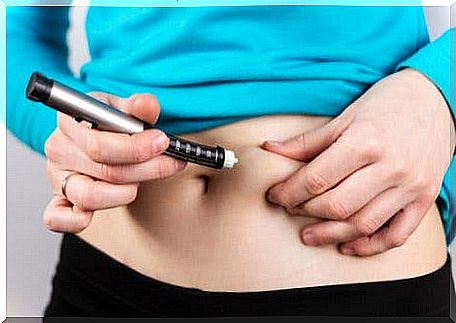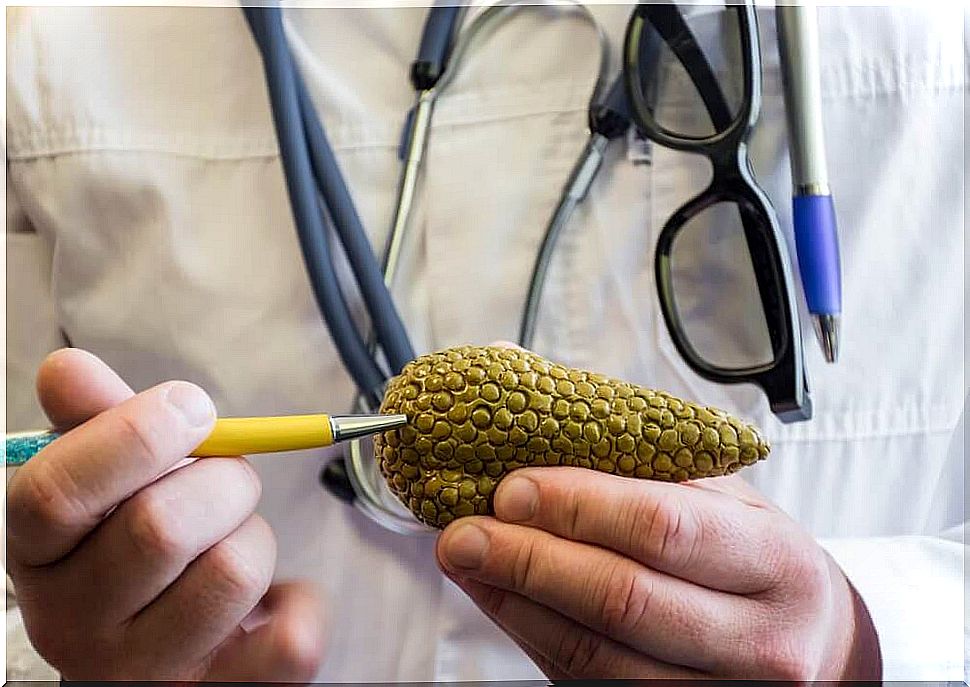Hyperinsulinism: What Is It?
Hyperinsulinism is an elevated concentration of insulin in the blood, which can have dangerous effects on health. Find out more about this topic today.

Insulin is a very important hormone, the main function of which is to regulate blood sugar levels. However, if the concentration in the blood is too high, it is called hyperinsulinism.
The lack of insulin is known as hypoinsulinism. For example, people with type 1 diabetes suffer from it. However, too high insulin concentrations in the blood are less well known and this also makes diagnosis more difficult. Therefore, today we are explaining to you facts that are worth knowing about this topic.
What is insulin
Before we explain what exactly hyperinsulinism is, let’s take a quick look at the key functions of the hormone insulin. This substance is produced by the beta cells of the pancreas and is also stored in this organ.
After eating, the organism processes the food eaten and breaks it down into molecules, which are then released from the intestines into the bloodstream. Glucose is one of these substances. Our body needs this type of sugar in order to gain energy and to be able to perform a wide variety of functions.
In response to rising blood sugar levels, the pancreas releases insulin into the bloodstream and directs the glucose to the tissues in the body that need it. So the insulin is responsible for getting the correct blood sugar levels.
Blood sugar levels and glycemia
Normal blood sugar levels are also known as glycemia. They are between 70 and 110 mg / dl on an empty stomach. Blood sugar levels that are too high or too low can have serious health consequences. A distinction is made between the following complaints:
- Hyperglycemia: abnormally high blood sugar levels
- Hypoglycemia: low blood sugar levels

What is hyperinsulinism?
We are talking about a serious illness in which the pancreas produces too much insulin even without taking in carbohydrates, which leads to chronic low blood sugar (hypoglycaemia). Then we go into more detail on possible causes :
Insulin resistance
In recent years there has been an increase in insulin resistance and type 2 diabetes. If the blood sugar level is not controlled for a long time, the pancreas produces more insulin in order to transport the glucose to the tissues and to keep the blood values constant.
But over time, the body gets used to these larger amounts of insulin. It therefore no longer reacts to smaller amounts, which leads to resistance.
To compensate for this resistance, the body makes even more insulin, which circulates in the blood. Hyperinsulinism with hyperglycaemia occurs.
Insulin-producing tumors
A less common cause of hyperinsulinism is insulin-producing tumors, also known as insulinoma. These are mostly difficult to diagnose tumors that are small and sometimes difficult to detect using imaging techniques. Around 10 percent of insulinomas are malignant.
These are tumors that arise in the beta cells of the pancreas and release a lot of insulin into the bloodstream. This hyperinsulinism means that all of the glucose is transported to the tissues and there is no longer any glucose in the blood. So we are talking about hypoglycemia.
Hypoglycemia is a serious situation. Possible signs of this are:
- nervousness
- Racing heart
- sweat
- irritability
- hunger
- Pallor, etc.
If the hypoglycemia is very severe, it damages the brain, which needs a lot of glucose. As a result, the following complaints can arise:
- a headache
- Blurred vision
- Paresthesia: tingling, mostly in the extremities
- Behavior changes
- confusion
- Twitches
- Memory loss
- Coma, in the worst case even death
So it’s a tumor that needs to be removed to prevent these symptoms. In addition, insulin is a growth factor that can lead to obesity.
Usually the insulinoma is located in the pancreas, but some patients have ectopic pancreatic tissue, which makes it difficult to diagnose. Fortunately, it is a very rare type of tumor.

External insulin hyperinsulinism
Another cause of hyperinsulinism can be insulin injections. This can be the case in the following two cases:
- A diabetic accidentally receives too much insulin, leading to hypoglycemia. As already explained, the situation is serious.
- Artificial hyperglycemia: This occurs when a person injects themselves with insulin even though they do not have diabetes. This is the case, for example, with Munchausen Syndrome, a mental disorder in which sufferers make up complaints and treat themselves or inflict self-harm in order to simulate an illness.
In both cases , blood sugar levels are very low, but insulin levels are high. However, the insulin is not produced by the body, but injected from the outside.
Hyperinsulinism: Important Keys
Most of the time, if someone has hyperinsulinism, they are insulin resistant. This means that there is too much sugar in the blood. This hyperglycemia is dangerous because it leads to diabetes and damages the cardiovascular system. We have also already mentioned that insulin is a growth factor and also promotes the development of tumors.
You should therefore control your blood sugar level and lead a healthy life. If you have problems with blood sugar levels, your doctor will prescribe various treatments to help regulate them. If you have symptoms of hypoglycemia, you now know that the problem is serious and that you definitely need to see a doctor!









